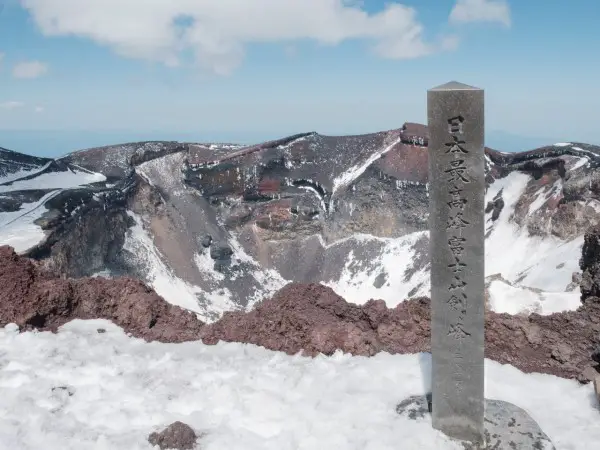
During the last regular climbing season lasting only two months from July to September, over 220,000 people climbed Mount Fuji (figures for 2023). While climbing Mount Fuji with 3,000 other people will definitely be an interesting social experience, it might not always allow you to truly appreciate its natural beauty because of the crowds. To be able to experience Japan’s most sacred mountain without the crowds, Mount Fuji off-season climb is a fantastic option.
Stay with me here if you want to:
- know the details of my awesome Mount Fuji off-season climb in one day,
- learn how to prepare for the challenging one-day ascent,
- read about descending from Japan’s highest peak on a small plastic sled and,
- meet the man who climbed Mount Fuji over 2,000 times.
What's in this blog post?
MOUNT FUJI OFF-SEASON CLIMB: THE DETAILS OF MY ASCENT
I have been living in Japan for more than two years and have travelled to its most remote regions – Hokkaido and Okinawa more than once. I have visited the Mount Fuji area several times. Although I could watch the iconic cone for hours and never get tired of this amazing view, it took me more than two years to decide to climb Japan’s most sacred mountain, which is quite unusual for a mountain lover like me. But almost everything that happens in our lives has a reason. We just don’t know it right away. I was supposed to climb Mount Fuji when the right opportunity came.
1. The most popular way to climb Mount Fuji
Despite its impressive altitude, Mount Fuji (3,776 m) is not a particularly difficult mountain to climb in the hiking season. There are lower peaks in Japan, which are far more technically demanding. However, very serious elevation gain, risk of altitude sickness, rapidly changing weather and strong winds make it a serious challenge for many people, especially for those less experienced or a slightly less fit.
Depending on your physical condition and the trail you choose to ascend (there are four), climbing can take anywhere from 5 to 10 hours and you need a few hours to descend. If you want to climb Mount Fuji in one day, it is going to be a long and tiring day. Therefore, the most popular and recommended way to climb to the top of Mount Fuji is a two-day ascent with an overnight stay at one of the mountain huts near the summit. This helps to spread the fatigue over two days, reduces the risk of altitude sickness and allows you to catch the iconic sunrise from the top of Mount Fuji.
But that wasn’t to be my way.
2. An opportunity to ascend Mount Fuji in May
I have recently joined one of Tokyo’s groups for mountain lovers on Facebook (Tokyo Hiking and Outdoor) and participated in a couple little group hikes. I found out that some of the group members climbed Mount Fuji off-season last year and saw some pictures that were just too good to be true. When in the middle of May I heard that this trip will also happen this year, it took me 10 seconds to consider all the pros and cons and submit my application.
Mount Fuji off-season climb was organized by David from Kanto Adventures who contacted me with a series of questions about my hiking experience and mountain gear. After two days, I received a confirmation email. Sunday, May 29th was THE day. I was supposed to travel from Tokyo to the foothills of Mount Fuji, climb to the top, safely descend and return home. All in one day. From that moment, I started nervously checking the weather forecast every day because in case of bad weather, the climb would cancelled.

the BIG day at 4.15 am.
It's really happening!
3. The day of the climb started early
Meeting time at Shinjuku Station was 5.30 AM. I went to bed at 10 PM but was too excited about the climb to fall asleep quickly, so I probably fell asleep just before midnight. I set the alarm clock at 3.45 AM. That wasn’t much sleep by my standards. The first thing I thought when it rang off was – why am I doing this to myself on a Sunday? There was no time to think so I quickly got up, had a coffee, stuffed the last things in my backpack and I left the house around 4.15 AM.
I grabbed my bicycle and cycled to Tokyo Station, stopping at two convenience stores to get my favourite hiking food – tuna mayo rice balls (onigiri). I was so stressed that I would miss the train or get lost at the enormous Shinjuku Station I am not so familiar with. But in the end, everything went fine.
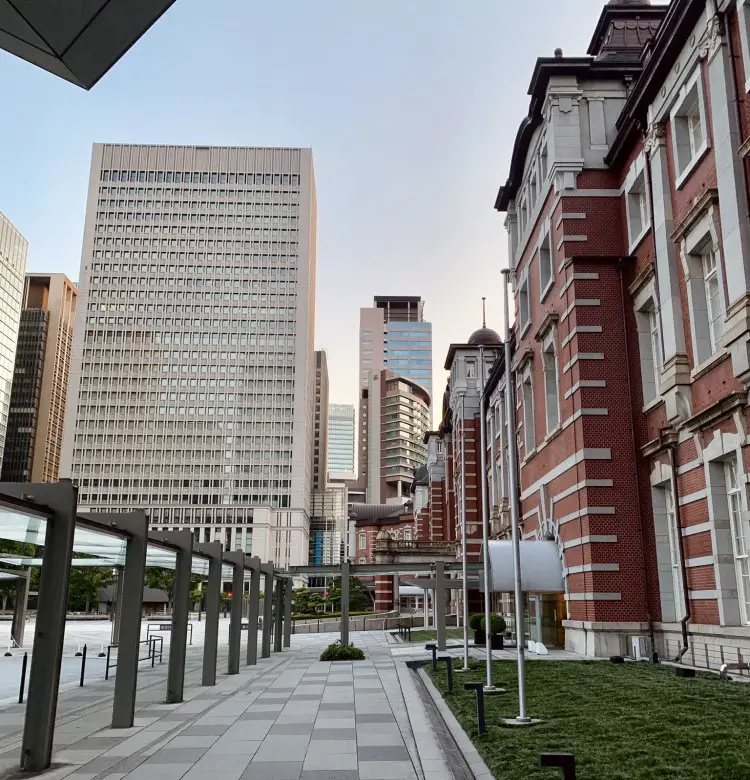

Meeting my guide and the rest of the group
I got on the first train at 4.59 AM with only a few other people – most of them judging by their outfits – crazy mountain lovers like me. I felt relieved immediately as I was not the only weirdo who instead of enjoying a Sunday brunch gets up at dawn to walk up a big pile of rocks.
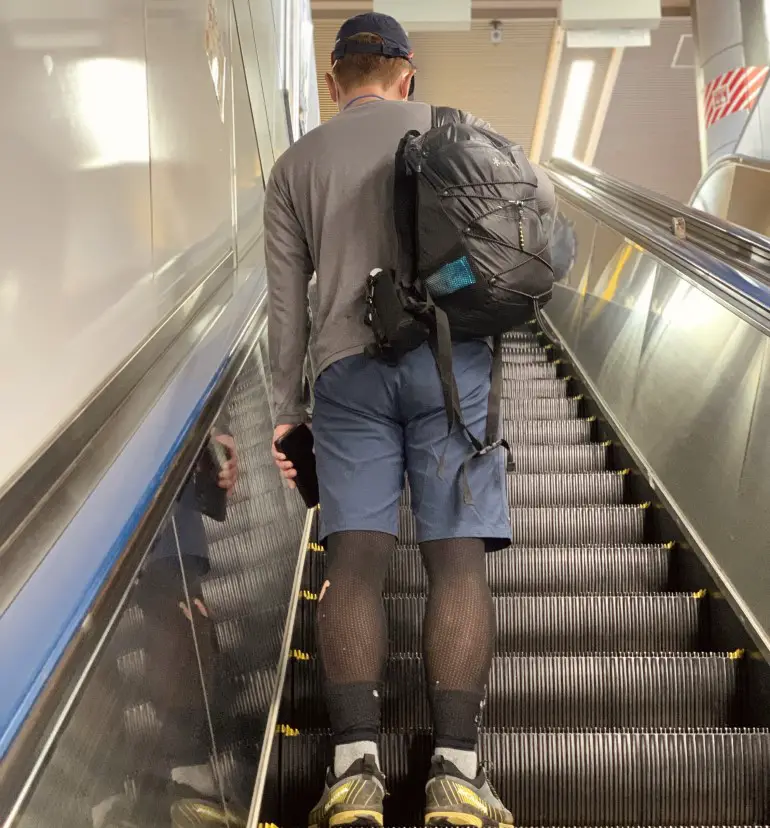
I'm not the only one who "likes" waking up early on Sunday
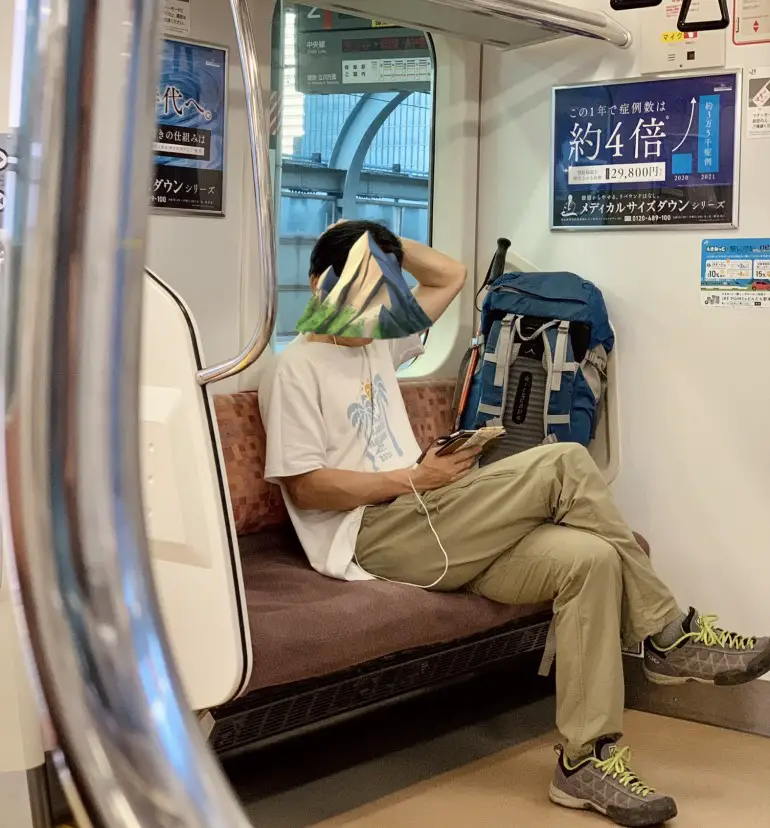
At 5.15 AM Shinjuku Station was unexpectedly busy with the younger crowd. Where did all these people come from? Hopefully from good parties – I thought. I met my guide David and the group – we were 10 people in total – outside one of the 200 (!) exits at Shinjuku station. We quickly got into the van and left at 5.30 AM towards Mount Fuji. After a one-hour drive I could get the first glimpse of the iconic cone.
With every kilometer Fujisan got closer and bigger
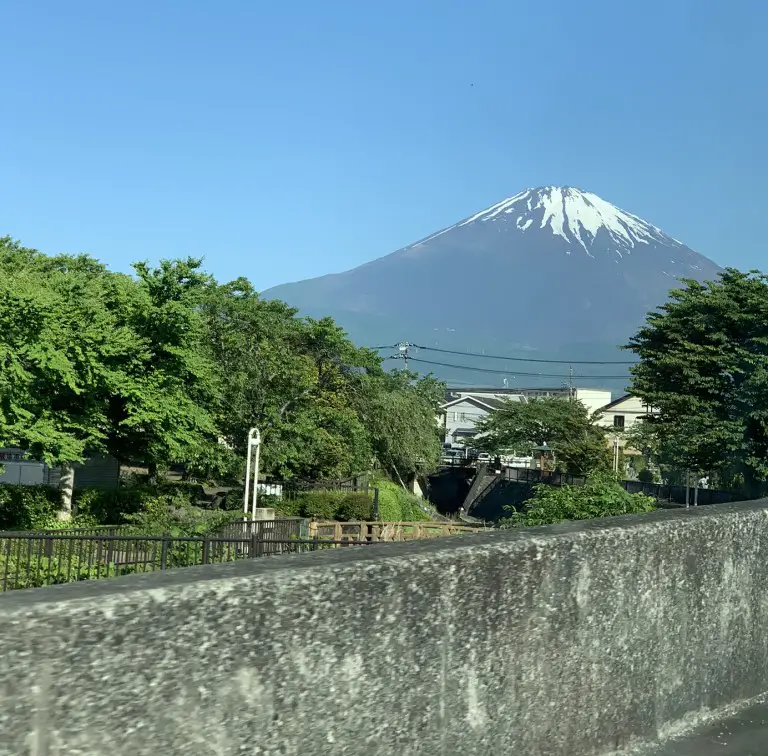
At the Fujinomiya trail head
Mount Fuji is divided into 10 stations, and each trail begins from its 5th station. We arrived at the 5th station of the Fujinomiya trail at 8 AM. This is where the road ends at 2,400 m on the south side of Mount Fuji in Shizuoka Prefecture. I was shocked as I thought we would be the only adventurers attempting Mount Fuji climb off the season, but the parking lot was almost full. Well, the world, especially on a sunny Sunday in May, is full of adventurous people. That’s so cool!
We were quickly briefed by David, each of us got the crampons, helmet, ice axe and a plastic sled. I was given a yellow helmet that matched the colour of my backpack – what a fantastic start! I packed light and stuffed all my things into my smallest backpack which did not turn out to be the best idea as it did not have the proper stripes for attaching the ice axe and the helmet. The crampons hardly fit into my backpack. A good lesson for the future. For a big adventure you don’t take a backpack suitable for a walk in the park.
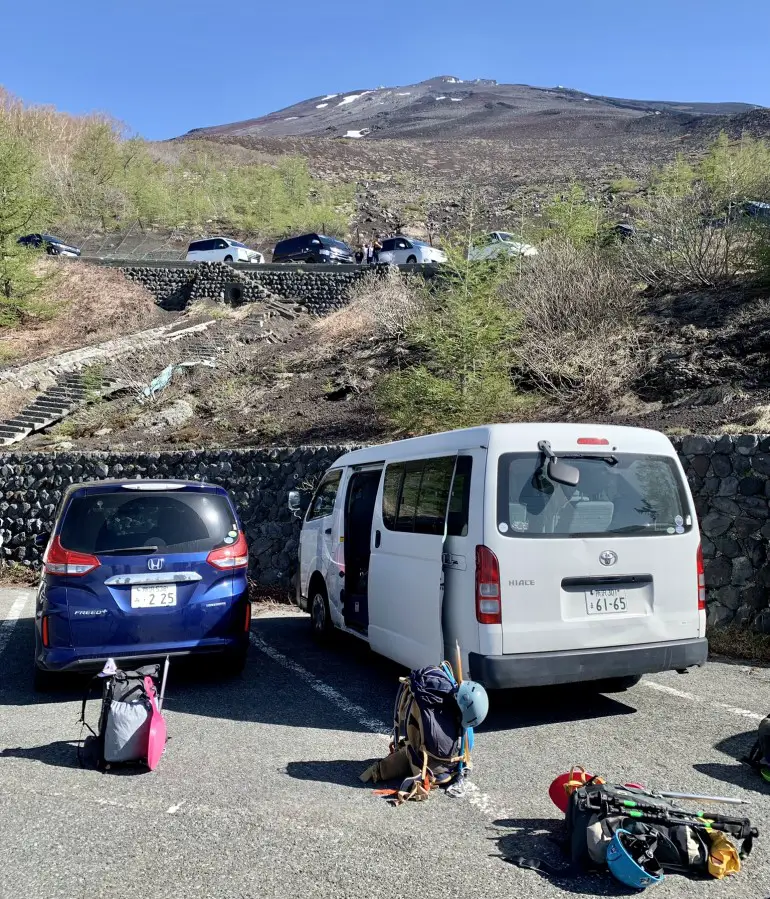
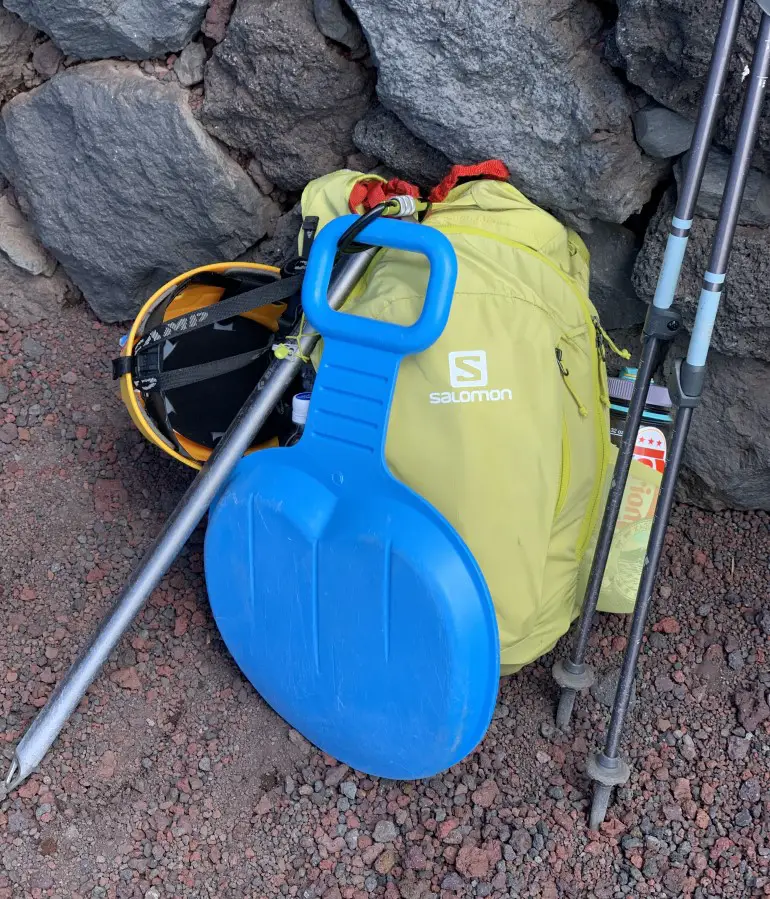
The thrilling beginning of Mount Fuji ascent
We left around 8.15 AM and climbed the shortest, steepest and most rocky route leading to the summit of Mount Fuji – the Fujinomiya trail. The climb just started, but you could already feel a thrill in the air. David announced that he would be able to assess our physical capabilities very quickly. If we can get to the 6th Station in 10 minutes, we should be able to get to the top before the 2 PM summit cut-off time. We all did it and were safe for at least a few minutes. The real test came soon.
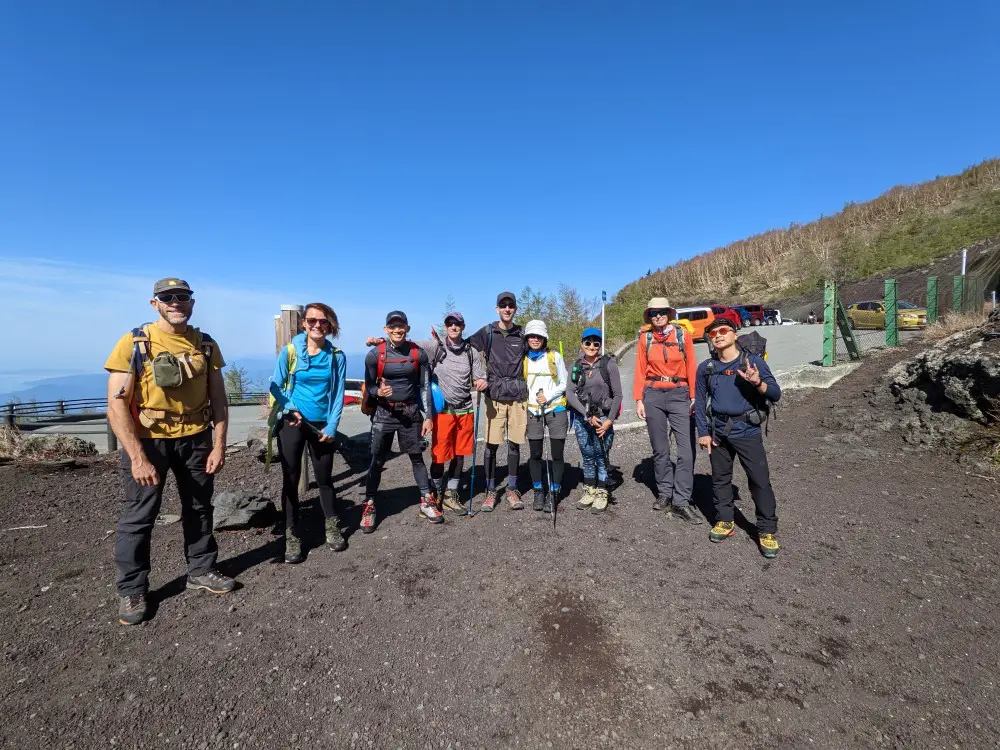
One of the conditions every participant agreed on while signing up for this climb was that in case you wouldn’t be able to hike from the 6th to the 7th station in 50 minutes, you would descend and spend the rest of the day in the van while others would climb the slopes of one of the most iconic mountains in the world. I know, not a very exciting prospect… But it was necessary, if we wanted to safely reach the top, descend and return to Tokyo the same day. Luckily, we got to the 7th station in 35/40 minutes and no one needed to have a difficult conversation.
I think I can do it 🙂
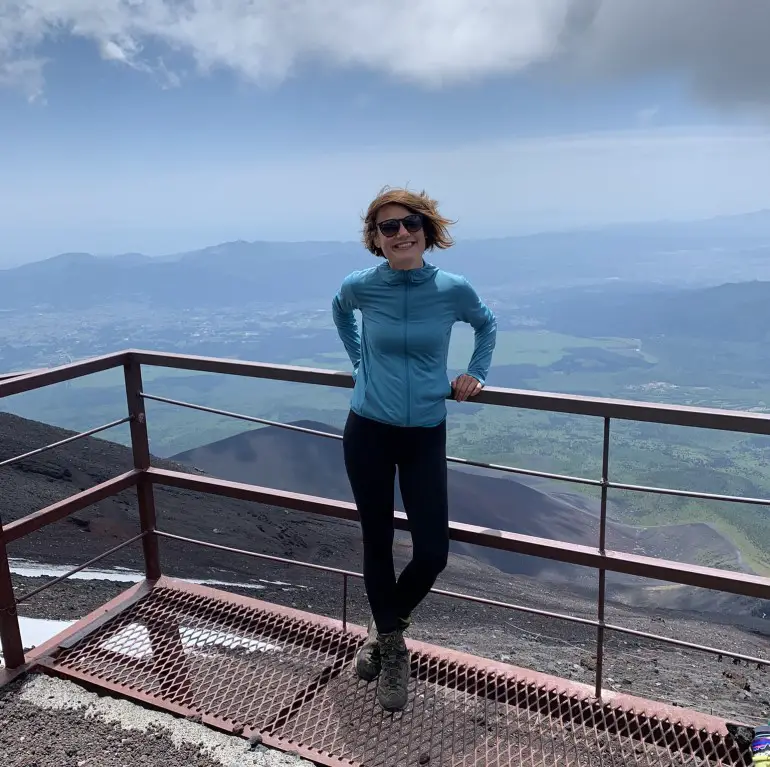
I wasn’t the slowest hiker in the group, which was my main concern when signing up for this trip, so I could finally relax. Although I knew that climbing Mount Fuji was within my capabilities as I did more challenging treks in Nepal, I wasn’t sure if I would make it in the required time. I usually hike alone and I’m not a fast hiker. My personal reason for climbing the mountain is not a physical challenge, but enjoying its beauty, the great sense of freedom only a mountain scenery gives me and… eating my snacks with an awesome view. Anyway, let’s get back to the mountain.
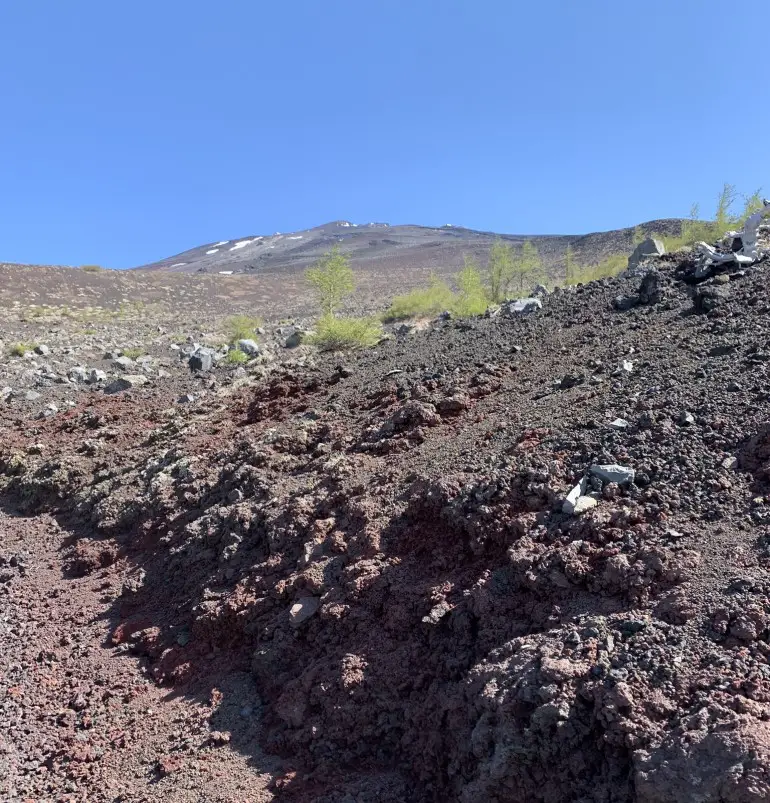
Mount Fuji is not the most beautiful while you climb it
Climbing Mount Fuji, which in fact is a huge pile of volcanic rocks, is a completely different experience than admiring the mesmerising view of its perfect snow-capped cone towering above the Tokyo metropolis or together with the famous pagoda surrounded by beautiful cherry blossoms. When you climb Mount Fuji all you see is volcanic ash. And if you do it during the regular hiking season, you are also surrounded by crowds of other people. The magic is practically gone. That said, it’s still an incredible adventure. The weather was absolutely fantastic, views stretched from the slopes of Mount Fuji over the far horizon.
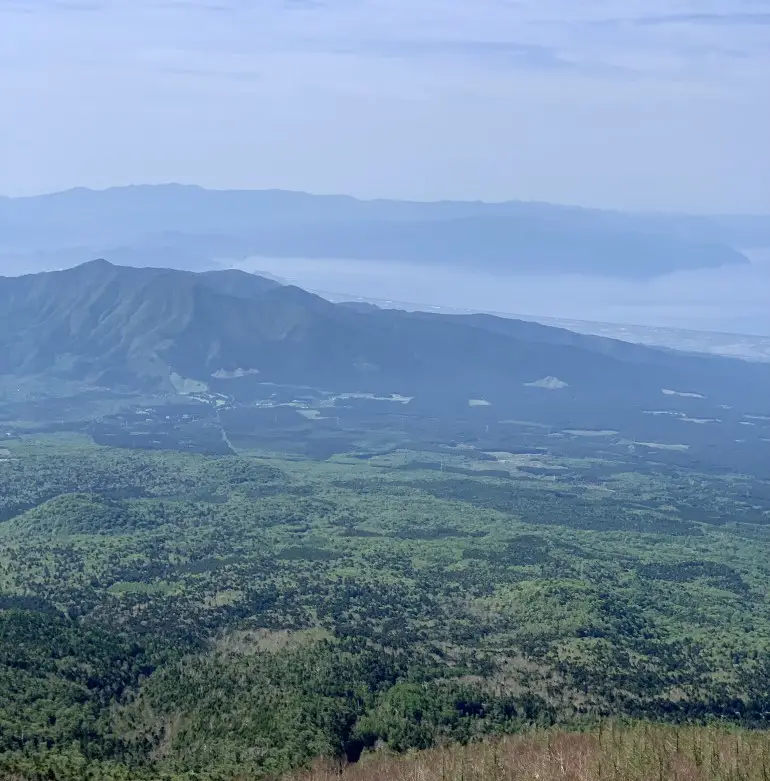
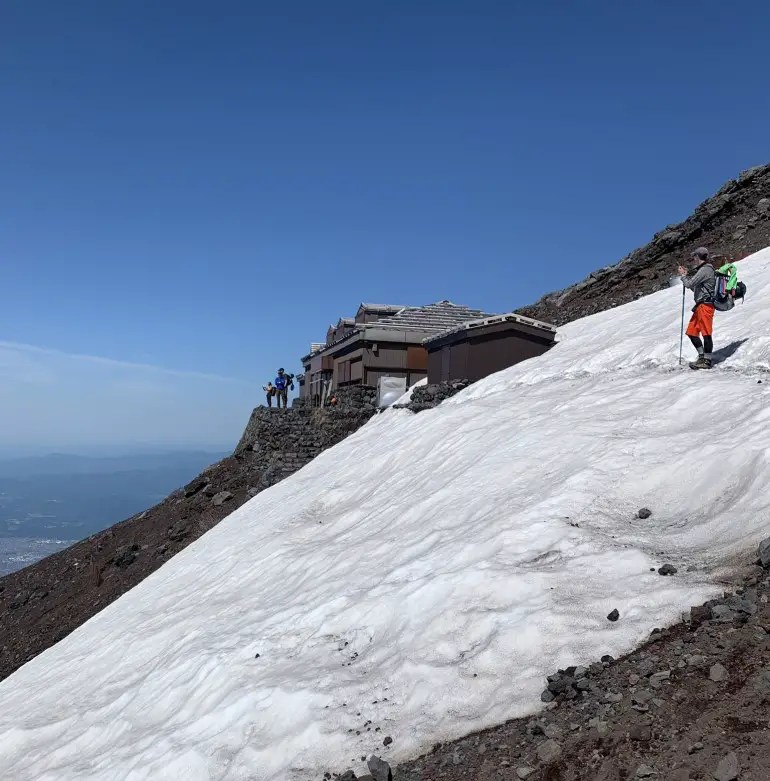
4. The risk of altitude sickness when climbing Mount Fuji in one day
We reached the 8th station, located at 3,250 m, after about 2.5 hours. I couldn’t believe it went so fast! It wasn’t even as hard as I thought it would be. Going up the stairs proved to be a good training strategy. I will tell you more about my preparation a bit later.
Due to the altitude, I started to feel a very familiar headache. I had similar pains in Nepal, but never at relatively low altitude like this. But well, a one-day Mount Fuji climb means really a huge elevation gain. You start from Tokyo at sea level and reach almost 4,000 m in just a few hours.
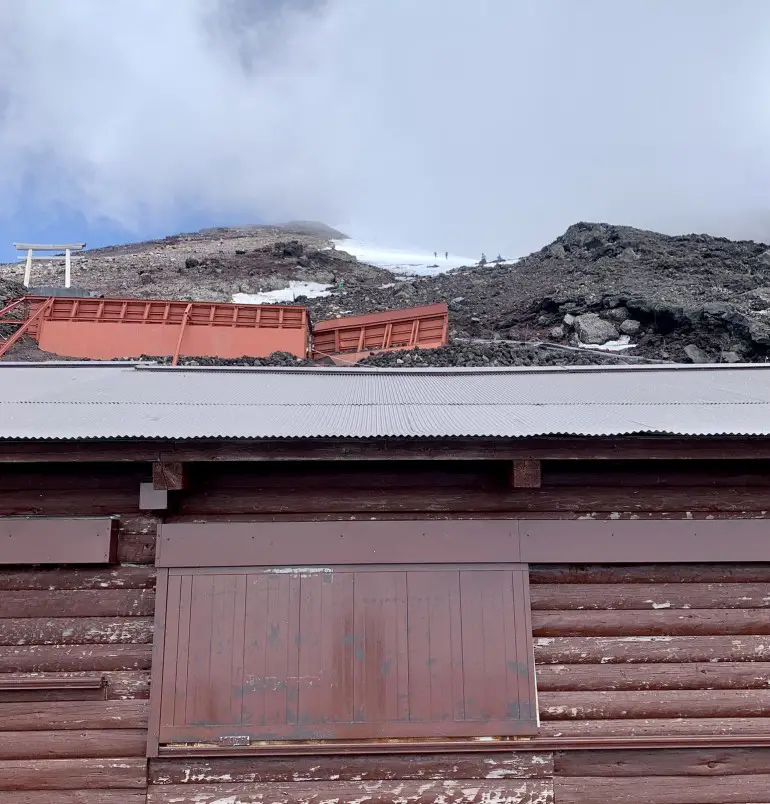
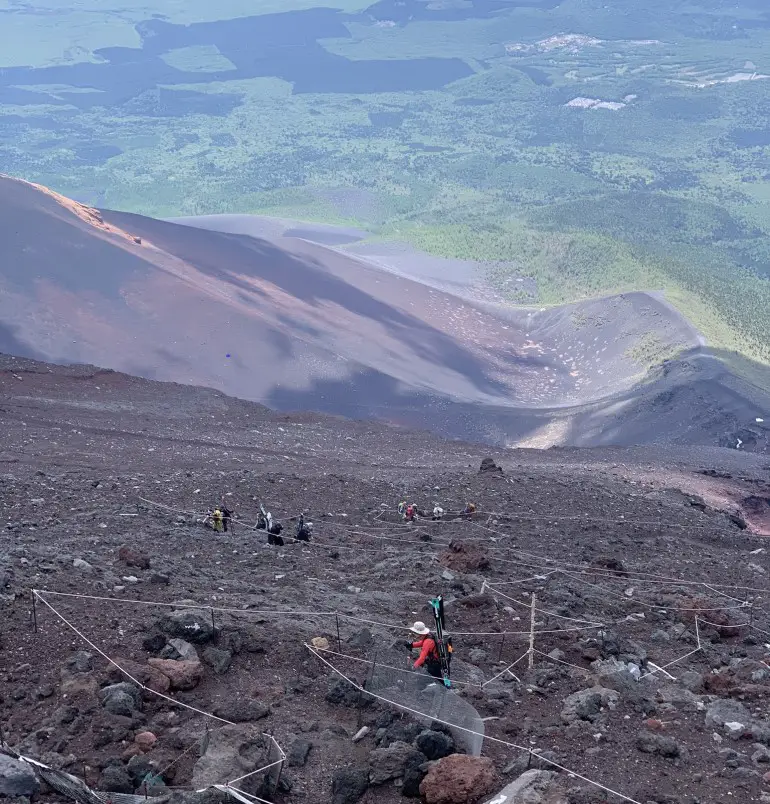
I think that summiting Mount Fuji (3,776 m) is comparable to reaching Tengboche (3,860 m) on Nepal’s most popular trekking route to the Everest Base Camp. So, let’s take a closer look and see the differences. First of all, even if you fly to Lukla (2,860 m) where most of the trekkers start their climb, you probably spent a few days earlier in Kathmandu at 1,400 m. That’s the first difference. Second, to reach Tengboche, you usually spend at least two nights somewhere on the trail at an altitude of 3,000 m or above as the walking distance is long. This helps with better acclimatisation.
Now you know why one-day Mount Fuji ascent is called the “bullet climb” and comes with the risk of altitude sickness. Mild symptoms such as a headache is a potential price to pay. Mine wasn’t that bad though. It was definitely less strong than the excitement and adrenaline rush at the thought of reaching the summit soon.
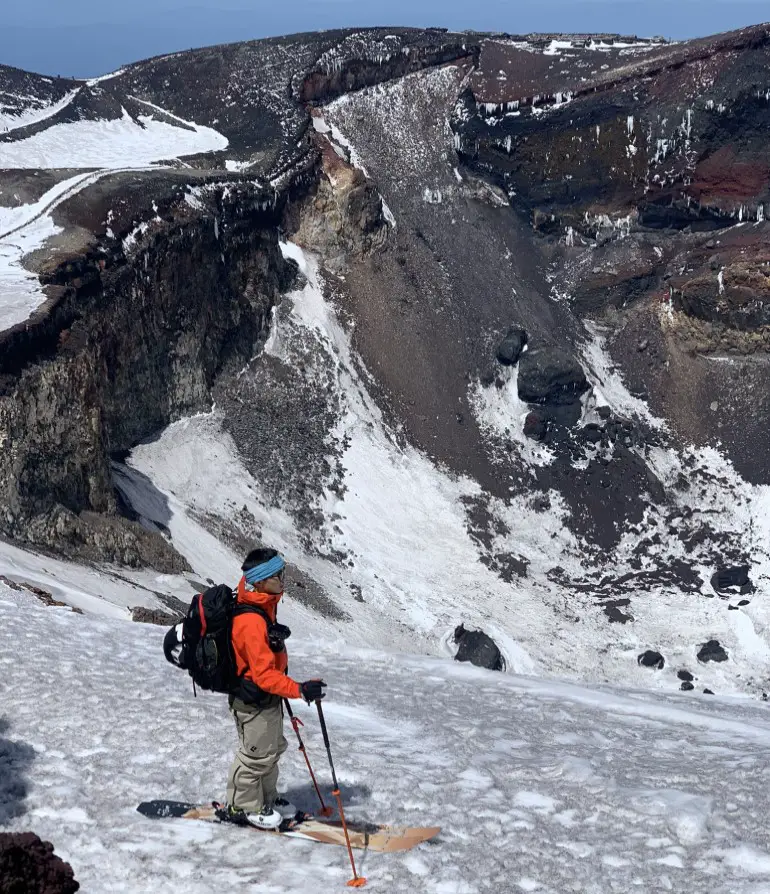
Skiing from the slopes of Mount Fuji
Signing up for this climb and being accepted made me feel good. Not everyone has the chance and capabilities to climb the sacred mountain/active volcano/Japan’s national symbol without the usual crowds and with snow on its slopes. I felt kind of a badass to some extent, which only lasted roughly until the 8th station.
This is where I first saw people climbing the slopes of Mount Fuji with a ski or snowboard attached to their backpacks. At some point, I noticed a man climbing in his ski boots. If you ski, you know how uncomfortable those are even when walking on a flat surface, and he was climbing the top of Mount Fuji at 3,776 m! When we got to the top, I saw snowboarders descending into the steep crater of Mount Fuji. Holy cow, that’s what real badasses do. I can’t even imagine how hard it is to climb back up.
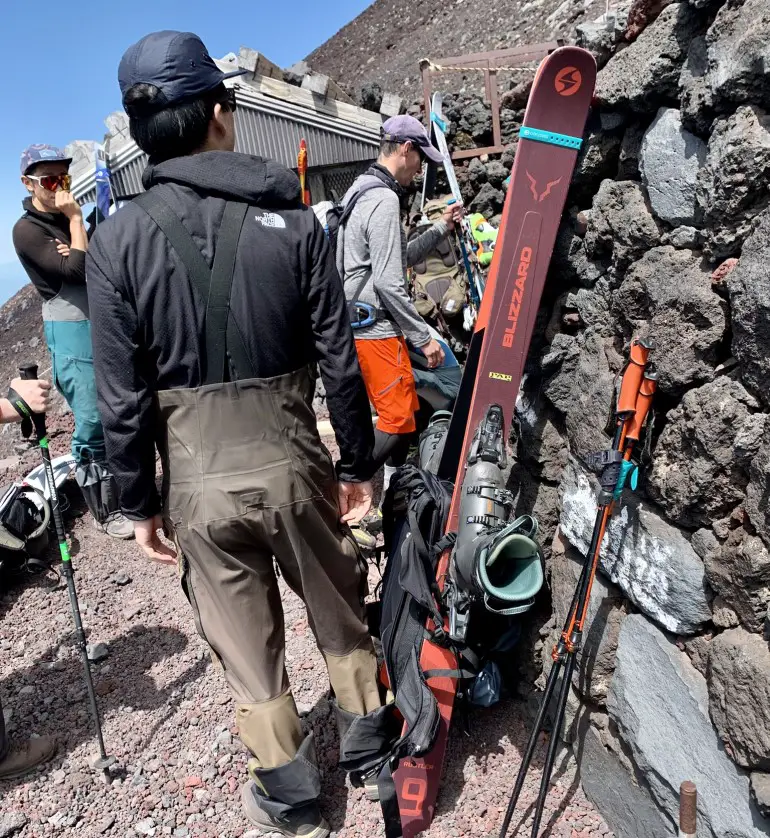
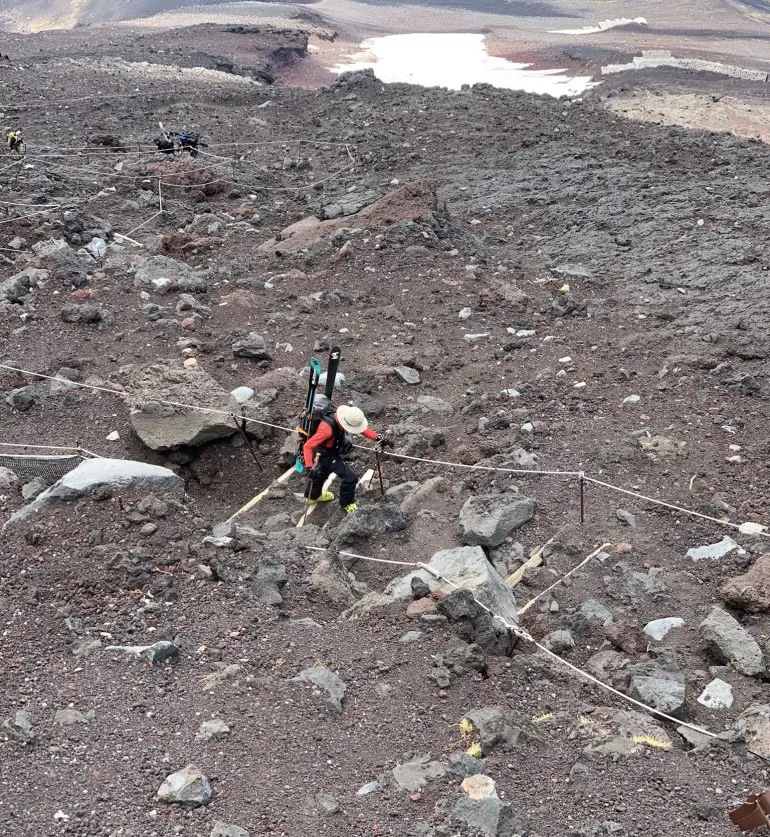
5. The man who climbed Mount Fuji over 2,000 times
Just below the 8th station, we met Mr. Jitsukawa-san. This 79-year-old Japanese, rather unassuming-looking, slowly ascended the mountain. Our guide stopped to say hello and we had a short conversation. Mr. Jitsukawa-san is often called Mr. Fuji-san for good reason. The number on his baseball cap conveys an important message. He had stood on the top of Mount Fuji 2,114 times! His ascent on the day of my climb was successful as we met him again on the top of Mount Fuji. Time to update the number on his cap.
He first climbed Mount Fuji quite late, at the age of 42, and was impressed by the sea of clouds below. He always loved the mountains, but over repeated climbs of Mount Fuji, Mr. Jitsukawa-san felt particularly fascinated by the mountain,
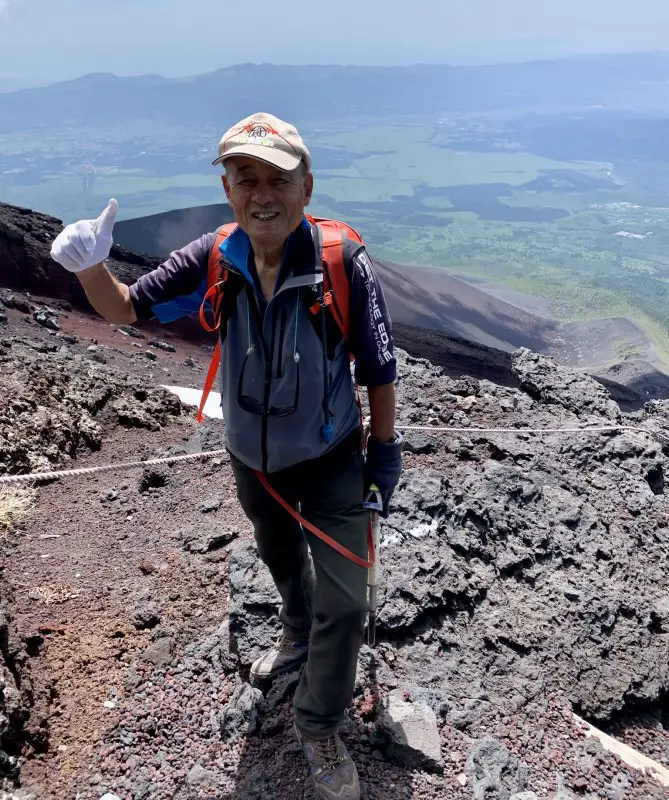
“Mount Fuji is the world to me now”
His impressive achievements include not only the world’s highest number of Mount Fuji climbs, but also 248 successful ascents in one year and two climbs a day for 75 consecutive days. He started climbing twice a day only after he retired. Can you imagine the surprise of other hikers who saw the same elderly man standing on the summit in the morning and climbing from the 5th station again in the afternoon?
When asked why he keeps returning to the same mountain, Mr. Jitsukawa says: “I’m the type of person who becomes obsessed with something once I take a shine to it. Mount Fuji is the world to me now. No matter how many times I climb it, the mountain looks completely different each time.”
I find our world so fascinating, full of diverse landscapes, offering endless experiences that I hardly ever return to the same place or climb the same mountain. I usually choose new destinations and challenges. I’m very impressed with Mr. Jitsukawa-san Mount Fuji’s lifelong project.
To understand his motivation, I searched the web and came across this article, from where I sourced the information for this chapter. Here you can also read more about his fascinating story: The man who climbed Mount Fuji over 2,000 times
6. Reaching the top of Japan
Just above the 8th station we reached the snow and saw the first skiers going down. I felt so lucky to experience Mount Fuji in such a unique way. Views were stunning. I could clearly see the Izu Peninsula and Oshima Island in the distance. The sky was blue, the sun was shining, and we were slowly making our way to the top.
Life is worth living for such moments
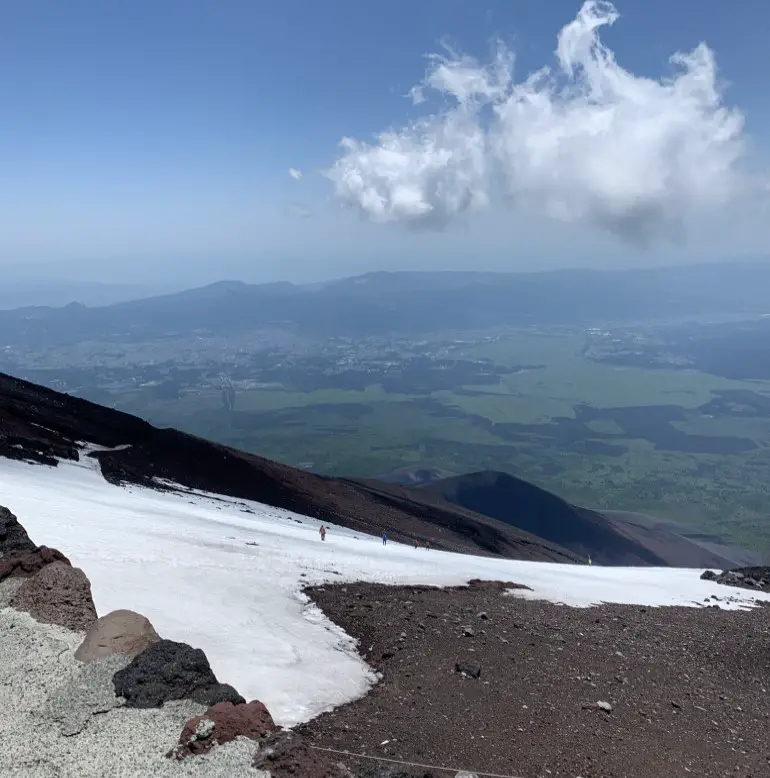
We reached the 9,5th station (3,590 m) at noon. We started putting on our helmets and crampons needed for the steep snowfield ahead – the final part of the climb. It was possible to climb the entire mountain without crampons if we used the bulldozer road at the end, but it was a nice challenge to climb the steep snowy slope instead. Our spirits were high. We were so close to the summit.
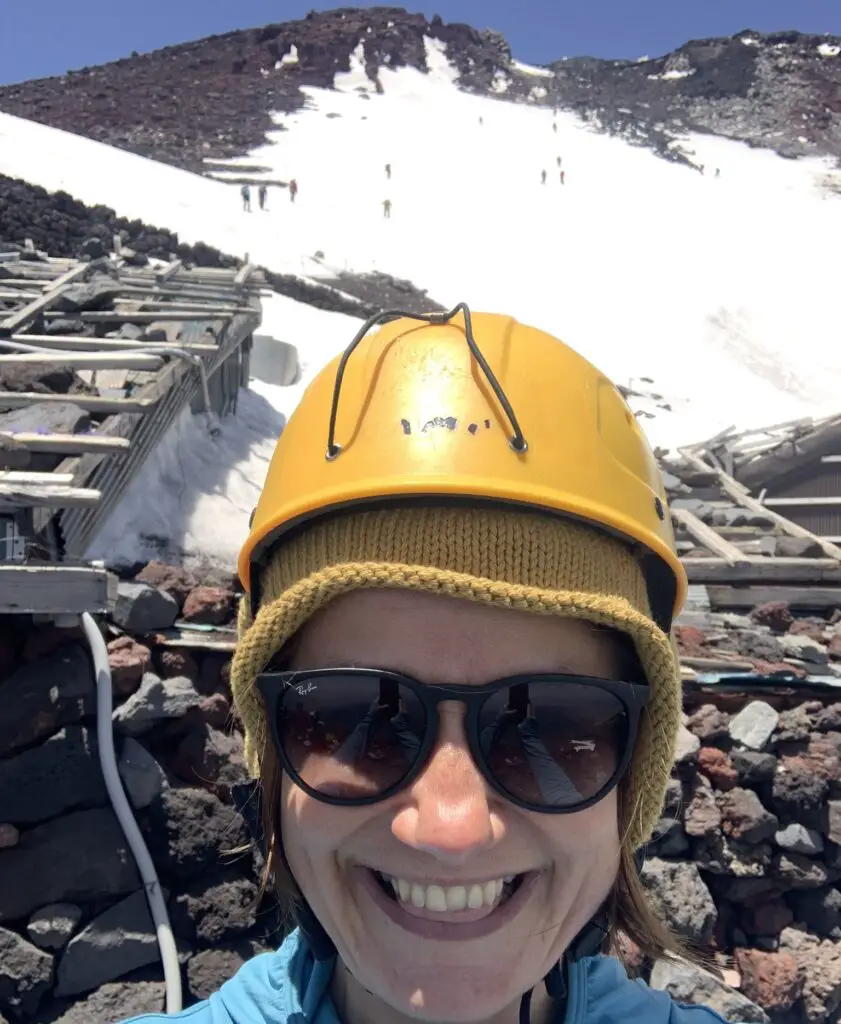
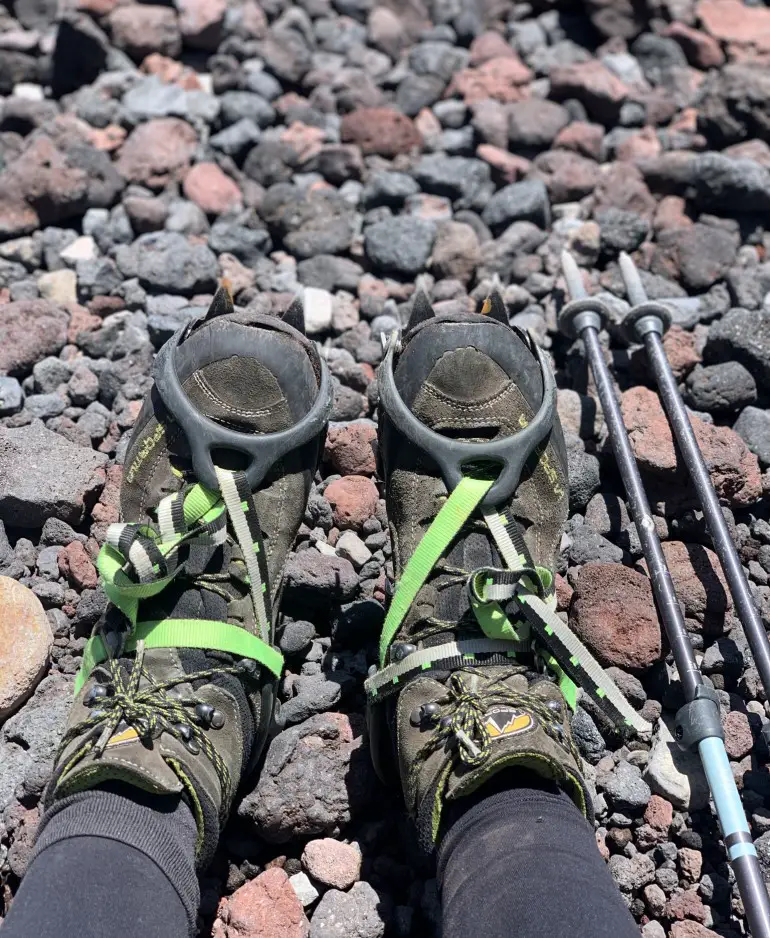
The spectacular crater of Mount Fuji
Just before 1 P.M I arrived at the picturesque tori gate of the Okumiya Shrine at 3,720 m. At first, I thought I was reaching heaven, but it wasn’t until I took a few more steps and turned the corner that I gasped with delight. I saw the sun-kissed summit and the crater all covered with snow.
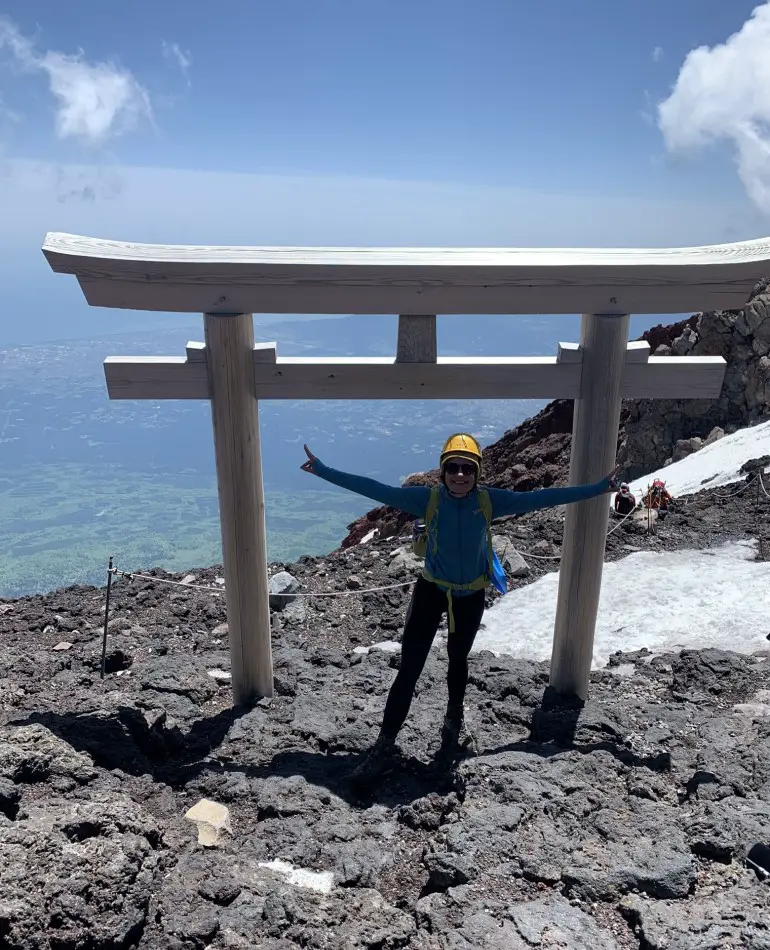
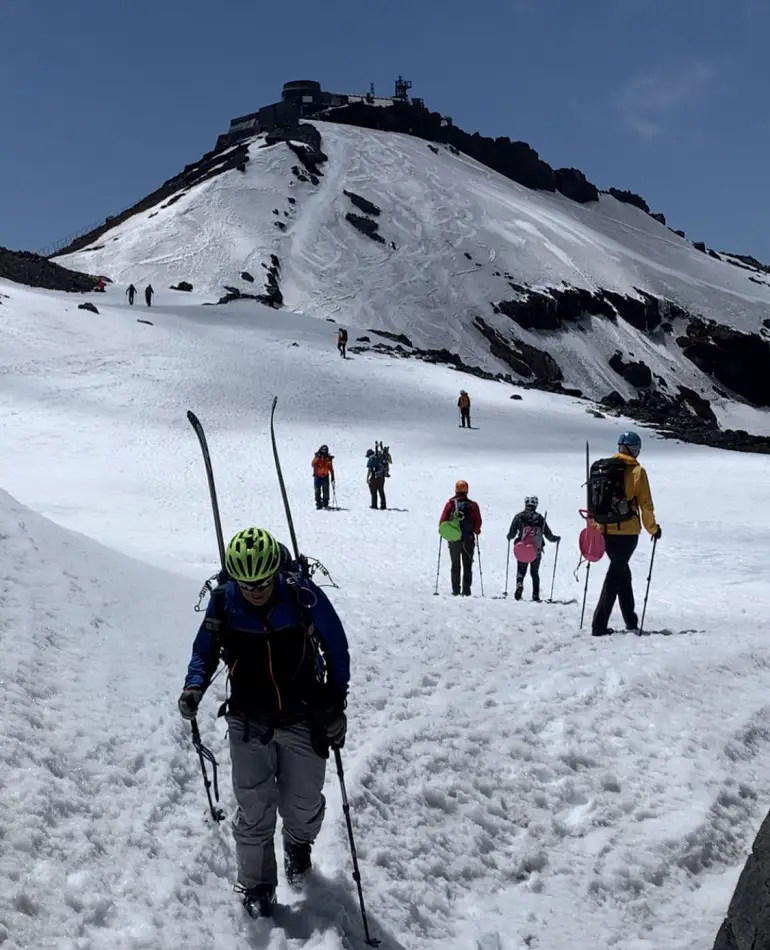
Mount Fuji might not be the most beautiful mountain to climb as already mentioned, but its crater is truly stunning. Standing on top of it, seeing it with my own eyes from such a close distance, was a truly powerful experience. The walk around the crater, which takes around 75 min, must be amazing. But we did not have time for this. I plan to climb Mount Fuji again in the summer in a typical 2-day way and am already looking forward to this 3km crater loop.
I returned to Mount Fuji in August and both the climb itself and the crater loop were amazing. Read more about my climb in the main season here: CLIMBING MOUNT FUJI FROM THE BOTTOM – THE YOSHIDA TRAIL.
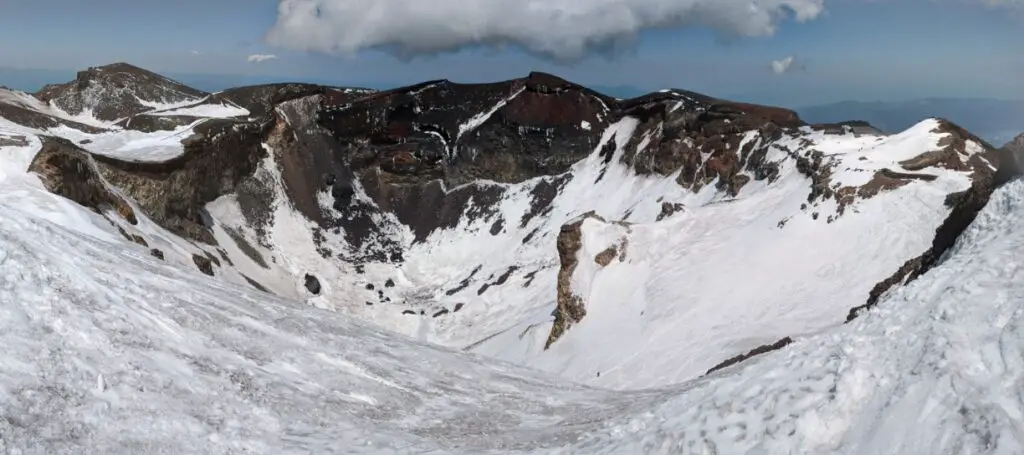
From the ridge of the crater, I climbed the last few metres to reach the summit. I couldn’t believe that I was standing on top of Japan – at its most iconic and beloved peak – Mount Fuji.

Standing on the roof of Japan
I took a few photos, sat down comfortably and searched for a suitable snack to celebrate this epic moment. If I were to describe what joy is – that was that moment. I was so happy. Only our group was at the top. Just below the summit, three snowboarders prepared to descend down the crater, while one skier climbed the steep slopes carrying skis. What a wonderful spectacle of human bravery and passion to watch with an onigiri in my hand.
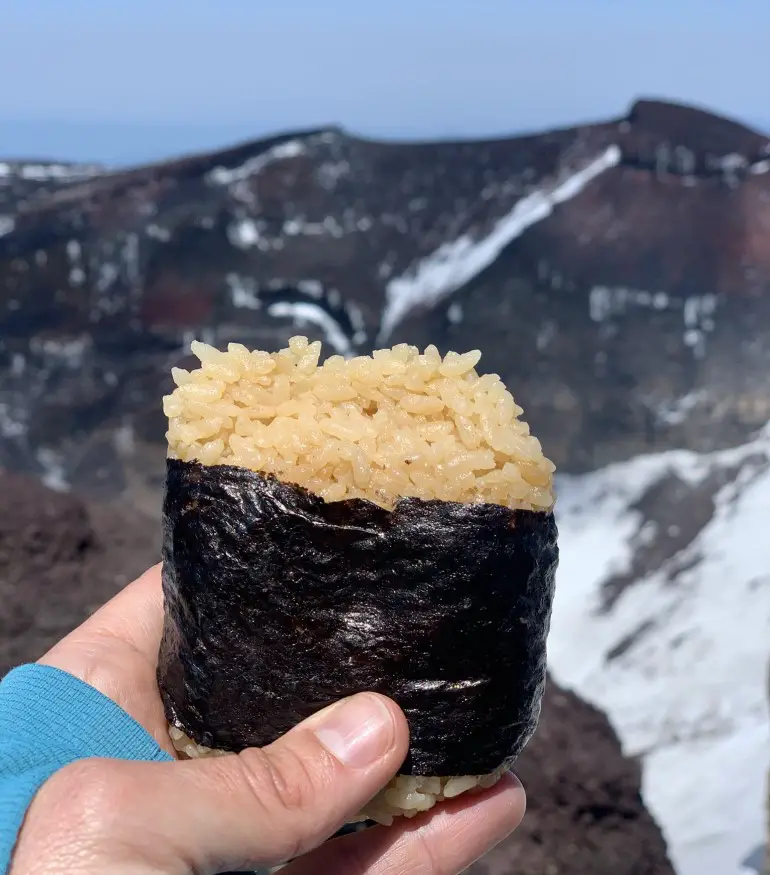
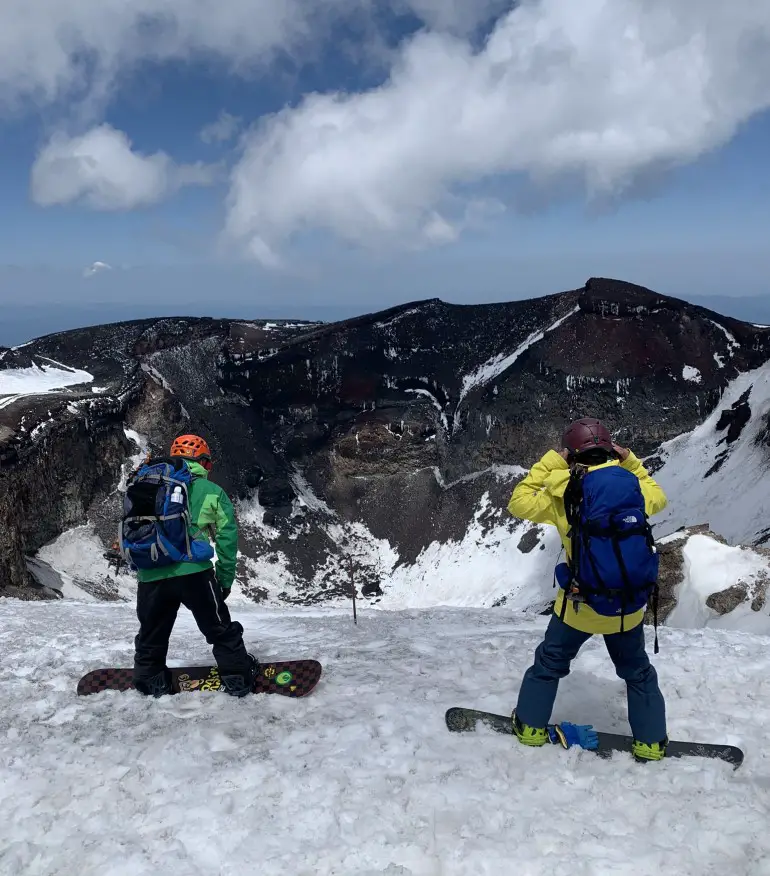
7. The adventure was not over yet
In fact, it was just the beginning of its funniest part. The snow conditions were good, the weather was perfect, we could sled down the slopes of Mount Fuji! Before going down, we had a little practice to learn how to attach the plastic sled to the backpack, how to regulate the speed with the ice axe and how to make an emergency break. It was quite scary. Descending felt fast and breaking was not easy. To tell the truth, if I were asked if I wanted to walk down or sled, I would probably choose the first option. Fortunately, this question was not asked.

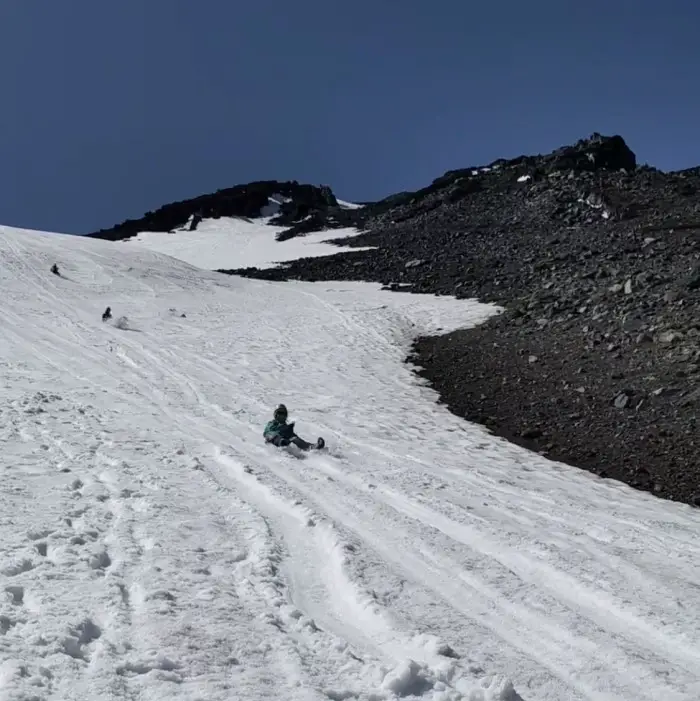
8. Sledding down the slopes of Japan’s sacred mountain
We sledded down from well above 9.5th station at around 3,625 m to the 8th station at 3,250 m. It became much easier and at one point I could even enjoy the views. What an amazing feeling it was! Descending on a plastic blue sled from the most sacred mountain in Japan can only be compared to paragliding from Mardi Himal at 4,000 m in Nepal, which I did a couple years ago. It simply can’t be described in words.
It was also a quick way to go down. Not sure how long it took, but descending the icy slope would definitely be more time-consuming and tiring. In short, if you ever get a chance, go for it! The vast slopes of Mount Fuji are the perfect playground for snow fun. Just don’t you dare to do it without an ice axe. The mountain is not entirely covered with snow. You must be able to break before reaching bare rocks.
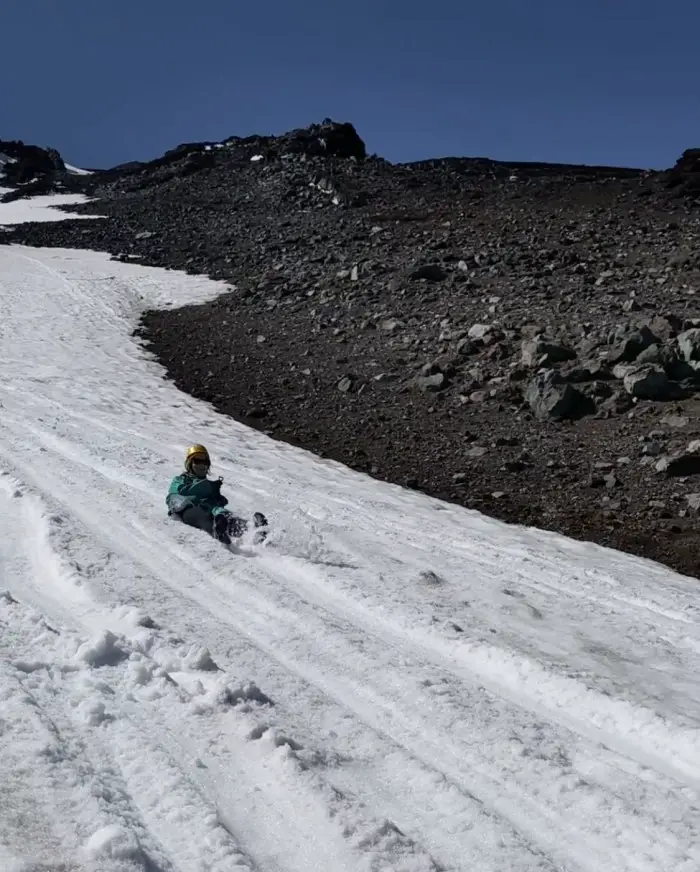
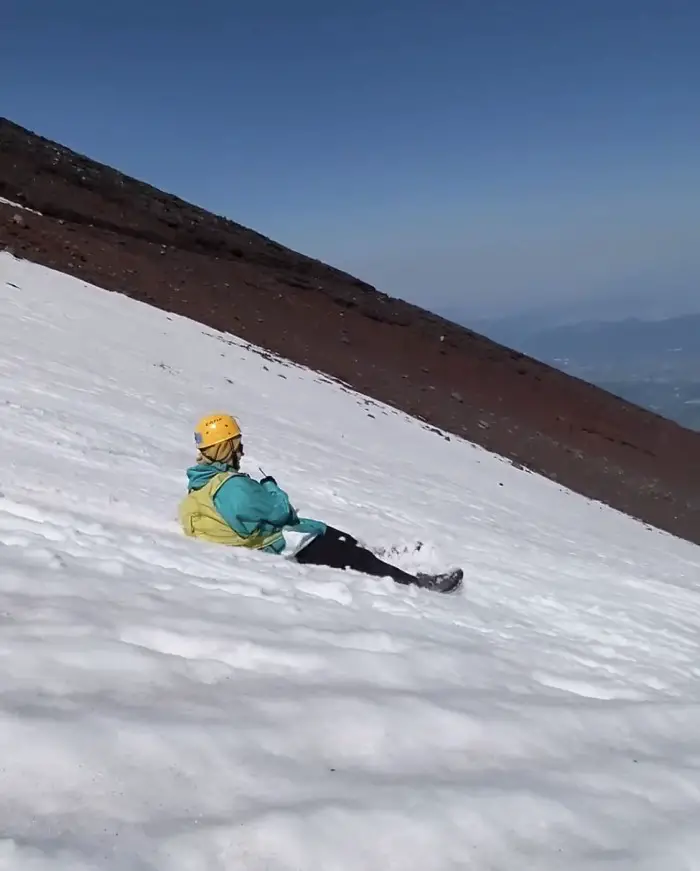
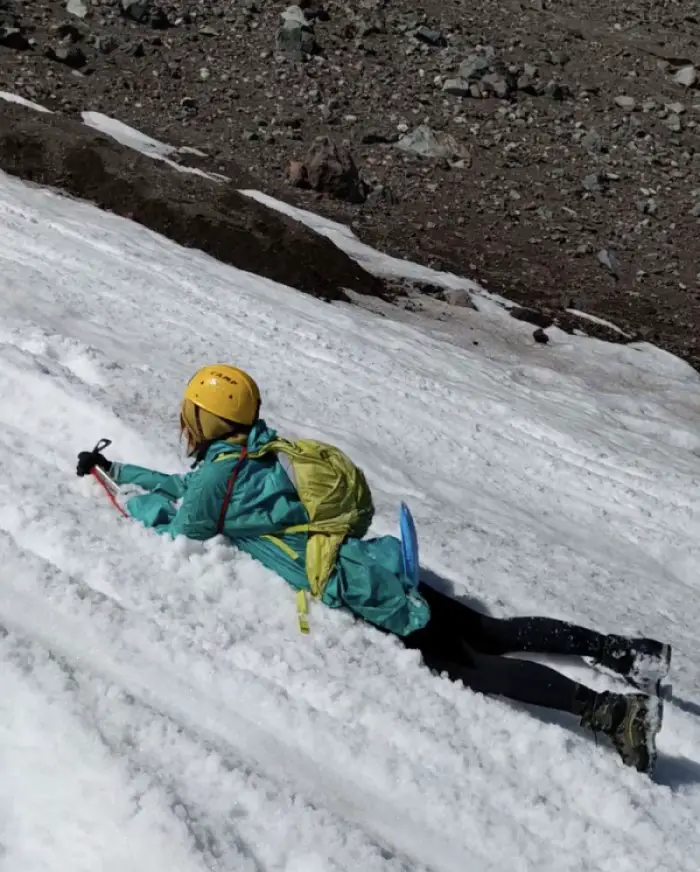
It was a really perfect day, beyond all my expectations. Even the last bit – 850 metres descent to the 5th station to our parked van was more enjoyable than expected. Being the shortest and the steepest, Fujinomiya trail can be very painful for the knees. As it was an off-season climb, we could take a slightly different route, not allowed for hikers in summer, which is the road normally used by bulldozers transporting goods to the mountain huts. The bulldozer road is longer but less steep. It may be a bit dusty, but personally I found walking down very easy.
Walking down the bulldozer road
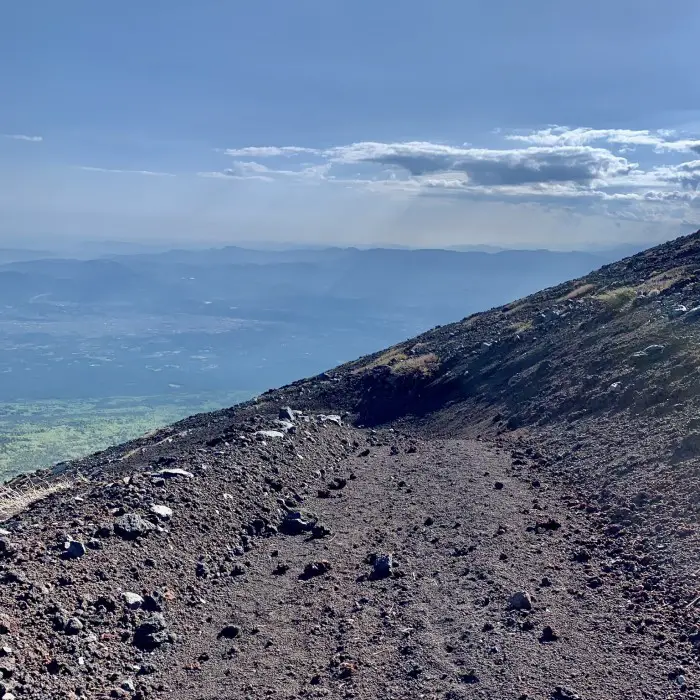
The end of the epic day
Around 4.20 PM we reached the 5th station. The climb took about 8 hours: 5 hours up & 3 hours down (included 1 hr spent on the summit and learning how to sledge). We cleaned a little bit, got into the van and David started driving.
The winding road from the 5th station called the Fujisan Skyline made me feel very sick. I get motion sickness easily, and the persistent headache didn’t help. I got much better on the highway. Unfortunately, there were several road accidents and we quickly got stuck in a traffic jam. I felt exhausted and I dozed off – something I rarely do in a car.
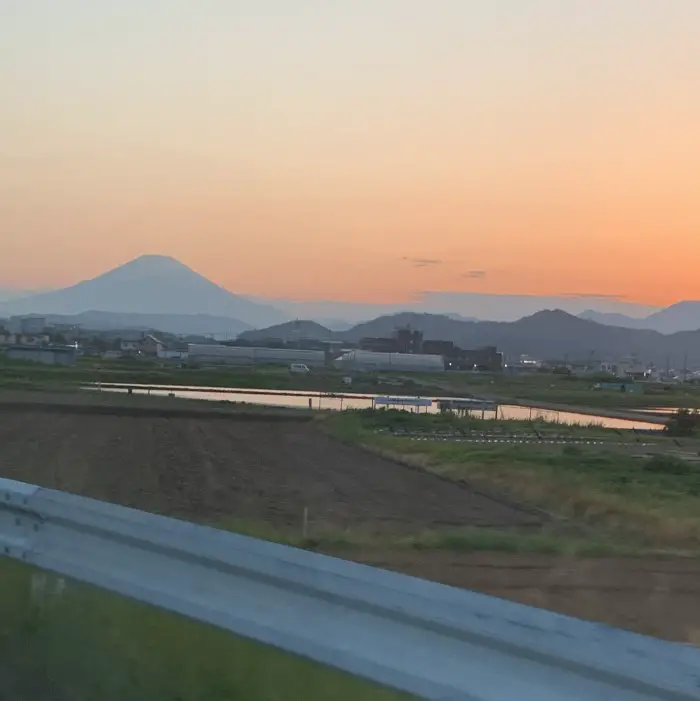
Fujisan says goodbye
After 2.5 hours, we were still somewhere in the middle of nowhere, very far from Shinjuku. David dropped us off at one of the stations on the Odakyu Line and we took the train. I arrived at the Tokyo Station where I parked my bicycle at 8.30 PM. Surprisingly, the bike ride home was pleasant. It felt unreal back in the neat streets of Tokyo, surrounded by tall concrete buildings and neon lights. I felt as if I had just woken up from a dream.
MOUNT FUJI OFF-SEASON CLIMB: PRACTICAL INFORMATION & TIPS
Is the one-day Mount Fuji off-season climb for everyone?
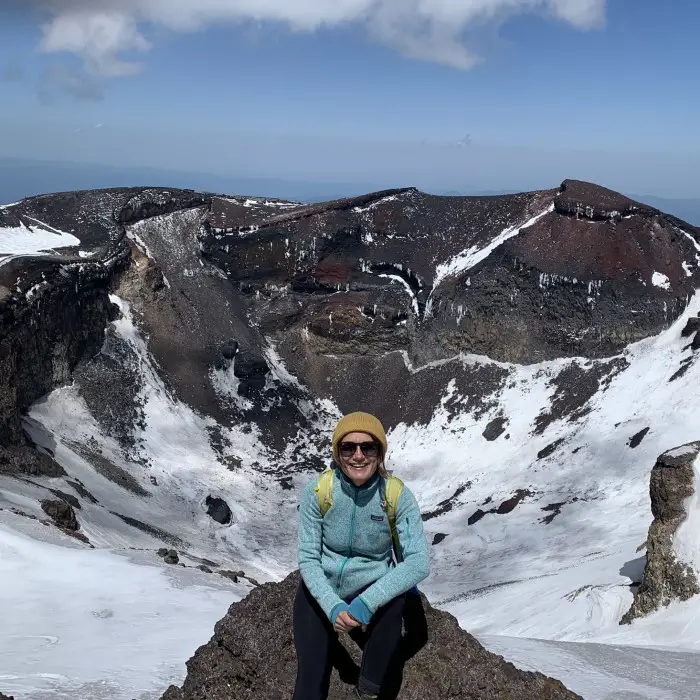

Is the one-day Mount Fuji off-season climb for everyone?
If you have never climbed any mountain, it’s definitely a bad idea. And I’m not talking about some hills. Ideally you should have mountain boots and gear, although renting in Tokyo is also available. You should also be reasonably fit as one-day Mount Fuji climb is physically challenging. As per Kanto Adventures fitness requirements – “As a minimum you should not even think about doing Mt. Fuji if you are unable to jog 5km (3 miles) in less than 35 minutes”, which in my opinion is a fair requirement but may not be enough. In case of any doubts, you should check the Kanto Adventures website or contact David directly. For Kanto Adventures website click here: HERE
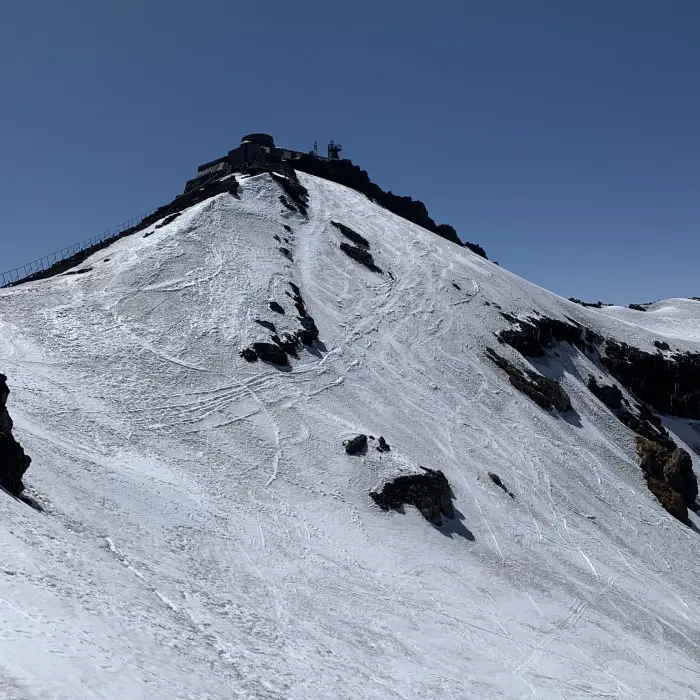
Is it the one-day Mount Fuji climb worth it?
Just look at the photo above and answer yourself 🙂 As long as you meet the necessary fitness / experience requirements, you should definitely go for it. Climbing Japan’s most iconic mountain without the usual crowds and vending machines is the best way to experience it. This is a unique opportunity to take a closer look at the famous Mount Fuji snow cap and sledding down its slopes is really unforgettable.
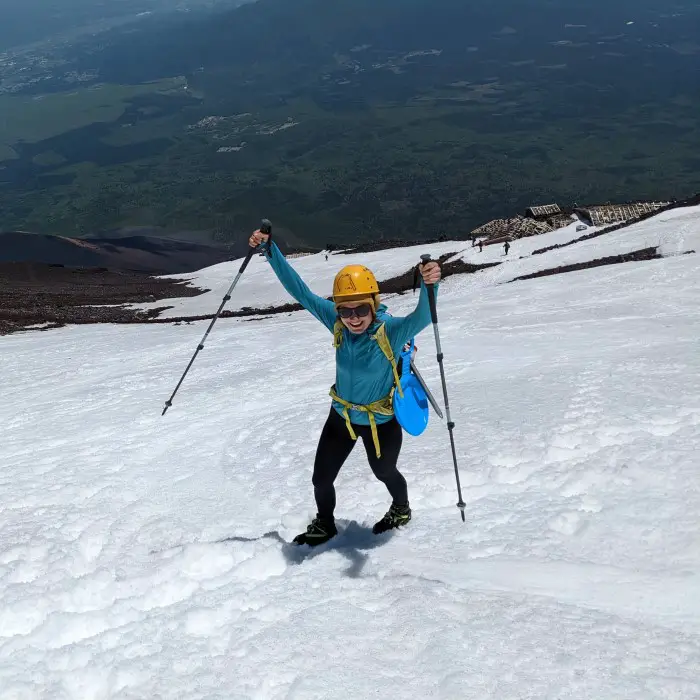
How to train before the one-day Mount Fuji off-season climb?
How to train before the one-day Mount Fuji off-season climb?

On good days, I can run 5 km in less than 30 minutes. Unfortunately, good days are less frequent lately. Because I had only two weeks to train, I did the easiest thing anyone can do, I climbed the stairs almost every day. And since I live on the 23th floor of the 40-storey tower, I was able to climb a lot. This simple exercise, which I warn you, is not pleasant at all, helps to strengthen your leg muscles, builds strength and stamina. It is perfect training for hiking any mountain. Just be gentle with yourself and listen to your body, as excessive exercise can easily do more harm than good and lead to injury.
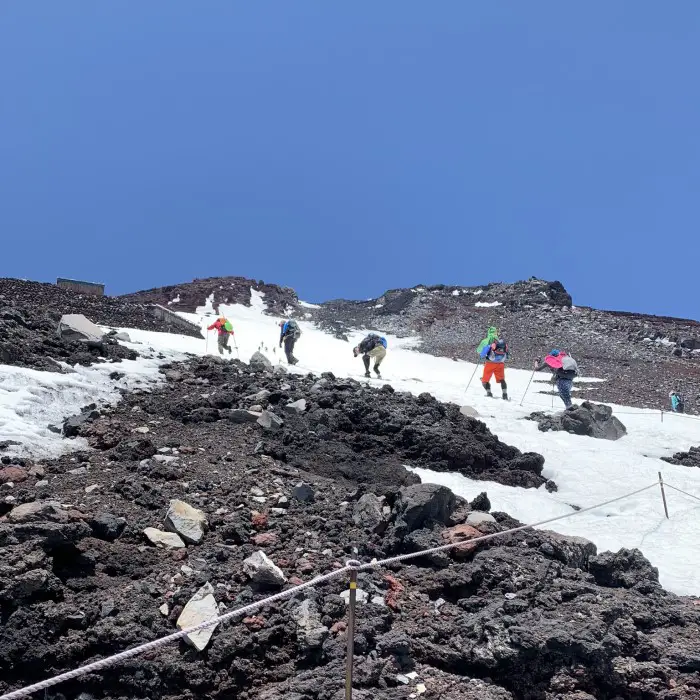
Is it possible to climb Mount Fuji without a guide?
In summer, when all mountain huts are open, medical assistance is available and lots of other people are hiking, with a little common sense always required in the mountains it’s definitely doable and safe.
Unless you have a vast mountaineering experience, you should not think about climbing Mount Fuji without a guide in the off-season. Weather can be very unpredictable and the risk of avalanches occurs. There may not be anyone to help you in case of any troubles. If there is still snow on the mountain appropriate mountaineering gear is required. Especially if something goes wrong you need someone with experience, someone who knows the mountain well. You can never be 100% sure whether everything will go well in the high mountains or not. Mount Fuji is almost 4,000 metres high. This height is no joke. The stakes are just too high.
I sincerely recommend Kanto Adventures. David is an experienced climbing guide, who has climbed Mount Fuji more than 100 times. His approach is very professional and last but not least, he is a very nice and funny guy.
Having said that, if you have the experience and plan to climb Mount Fuji off-season without a guide, check out my latest article. Questions from 88-93 relate to climbing Mount Fuji in the off-season and might help you in planning.
Can you climb Mount Fuji all year round?
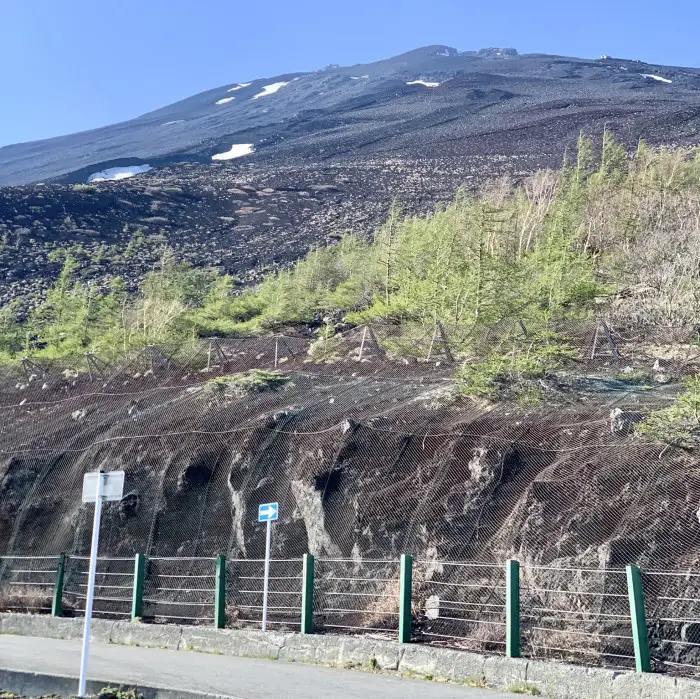

Can you climb Mount Fuji all year round?
No, you can’t. The road to the 5th Fujinomiya Station must be open, but it is closed during winter from late November to late April. In the off-season, buses are only scheduled for the Fuji Subaru 5th Station (Yoshida Trail). Note that they might not go sometimes due to snow.
Mount Fuji is extremely cold in winter when temperatures reach -40C. It can be very windy and icy. Unless you are an alpinist experienced in winter mountaineering you should not attempt to climb Mount Fuji in winter as it is very dangerous.
Therefore, if you want to avoid summer crowds on Mount Fuji climb, have sufficient hiking experience and a good level of fitness, you can ascend Mount Fuji in spring or autumn. Climbing Mount Fuji in the off-season is an unforgettable experience that I hope, at least to some extent, I was able to put it into words how magical it can be.
MORE RESOURCES FOR MOUNT FUJI CLIMBING AND NOT ONLY
100 questions with 100 detailed answers. There is everything you need to know before climbing Mount Fuji. And if something is missing, let me know, I will add.
100 THINGS ABOUT CLIMBING MOUNT FUJI
Practical details how to prepare including a complete packing list and what to expect from the climb.
HOW TO CLIMB MOUNT FUJI & HAVE FUN? TIPS TO PLAN THE CLIMB
A story of my 3-day Mount Fuji summer hike, great for those who want to climb the entire mountain, not just it’s half.
CLIMBING MOUNT FUJI FROM THE BOTTOM – THE YOSHIDA TRAIL
My third Mount Fuji ascent – a 2-day climb hike via my favourite route.
CLIMBING MOUNT FUJI OFF THE BEATEN PATH – THE SUBASHIRI TRAIL & PRINCE ROUTE
If climbing Mount Fuji feels a bit too challenging for you, perhaps camping under its iconic peak or enjoying a pleasant bike ride around one of Fuji’s lakes, with plenty of time to relax, would be more suitable for you? 🙂
CAMPING UNDER MOUNT FUJI & CAMPERVAN TRAVEL IN JAPAN
LAKE KAWAGUCHI IN 2 DAYS – HOW TO FALL IN LOVE WITH MOUNT FUJI?


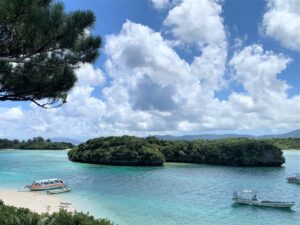
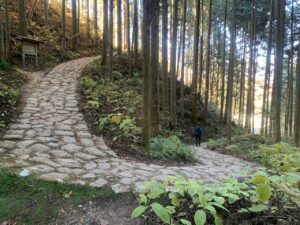
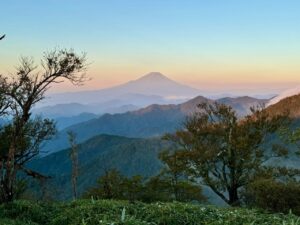
This is amazing.
I enjoyed reading this. This something I want to do.
I climbed Fuji 2 times in the regular season but I would love to experience it in the off season. It doesn’t look that difficult at all.
Any tips or suggestions would be greatly appreciated.
Hi Heather, thank you for your comment! If you are relatively fit and have climbed mountains before, especially if you have summited Mount Fuji before, it’s totally doable, go for it, it’s amazing! But in the off-season I recommend you to go with the guide – Kanto Adventures is great. Since I was lucky with the weather and there were other hikers climbing on that day and not much snow left, some people might be tempted to try climbing alone. But I think it’s not a good idea.
It’s important to know the snow conditions before and be prepared, and without a guide it is impossible. I know other people climbing in May had a very different experience from mine – they needed to use crampons / or experienced bad weather. Also if you injure yourself, there might be no one to help you. I had no signal on the mountain.
This is a wonderful write-up! Thank you for sharing your experience.
Thank you! It’s always so nice to receive good feedback 🙂 I’m replying only now as I was travelling and had no pc – it was a real holiday/family time 🙂 Actually, I just got back to Tokyo and… immediately started planning a new trip. And you know what? While searching the internet, I came across your beautiful article about your happy place – Tokashiki Island <3 The world is so small! It's unbelievable! Even the huge online space is so small at times. In short, in 2 days I'm going to stay at Kerama Backpackers for 4 nights. I think we need to catch up someday 🙂
Hello,
This article is very helpful and your experience seems very inspiring!
I am considering to try this hike but I have some concerns.
I have experience hiking mountains (just below 3000) but with good fitness level. And a little ski experience as beginner.
I am ok with endurance but I have a bit fear of heights when being in suspension (for example I can’t do rock climbing or stair suspended form rocks due to fear stress) but anything feeling safe I can easily do.
So I wanted to ask you how risky did it feel in terms of suspension? Especially during the descent skidding I am worried I might get the fear I’m case the inclination is too big? Or is there option with this guide to descent from the path and not slide?
Many Thanks,
Despoina
HI Despoina, thank you so much for reading. The inclination is not so big, but it’s probably very relative. I was more scared of speed than the inclination, but on the other hand, both are related, aren’t day? Sliding is not always part of the climb as it really depends on the snow conditions, the exact time of the year you climb Mount Fuji. You need to be lucky (or unlucky?;)) to have a chance to slide down Mount Fuji. I recommend you to contact directly the organizers of the tour – Kanto Adventures (https://www.kantoadventures.com/) and speak about your concern.
Really helpful. Thank you
Happy you like it 🙂 Good luck with Fujisan!
The least confusing information out there for Mount Fuji!! Very helpful. Thank you for stopping me going crazy.
Thank you for making my day 🙂
Hi,
I have been doing my research on off-season climbing for Mt. Fuji and this article was super helpful! (THANK YOU). Thank you for recommending Kanto Adventures. Good to know that they offer off-season climb guide since I will be in Japan mid- to late-October and have been thinking about hiking then. I have hiked the Grand Canyon in February (east rim all the way down to the Colorado river and then back up in one day), Bryce Canyon (also in Feb), hiked in Aspen (in terms of acclimating to. altitude changes) and done a few 4,000-footers in the New England area. I also have snowboarding experience so I have the proper gear for the snow/cold (if hiking Bryce Canyon in Feb doesn’t already give that idea lol). I am in relatively good physique and I think I can do climb Mt. Fuji.
Based on your experience, do you think I should go through Kanto Adventures for a bullet climb in late October of this year 2023 (thinking 10/20 or 10/26)? I really want to catch the sunrise. Also, would I still need to submit an off-season climbing form if I do?
Thank you so much in advance!
Hi Ting, I’m happy you liked my article and thank you for your comment. If you go with Kanto Adventures it will not be a bullet climbing. You will climb during the day. Although you won’t see the sunrise, it will be awesome. Bullet climbing (climbing from the 5th Station at night with the intention of reaching the summit by sunrise without staying in a hut) is not a good idea in the summer season, not to mention off-the season. If you contact Kanto Adventures they will assess your fitness for the climb and take care of all permits. Hope it helps!